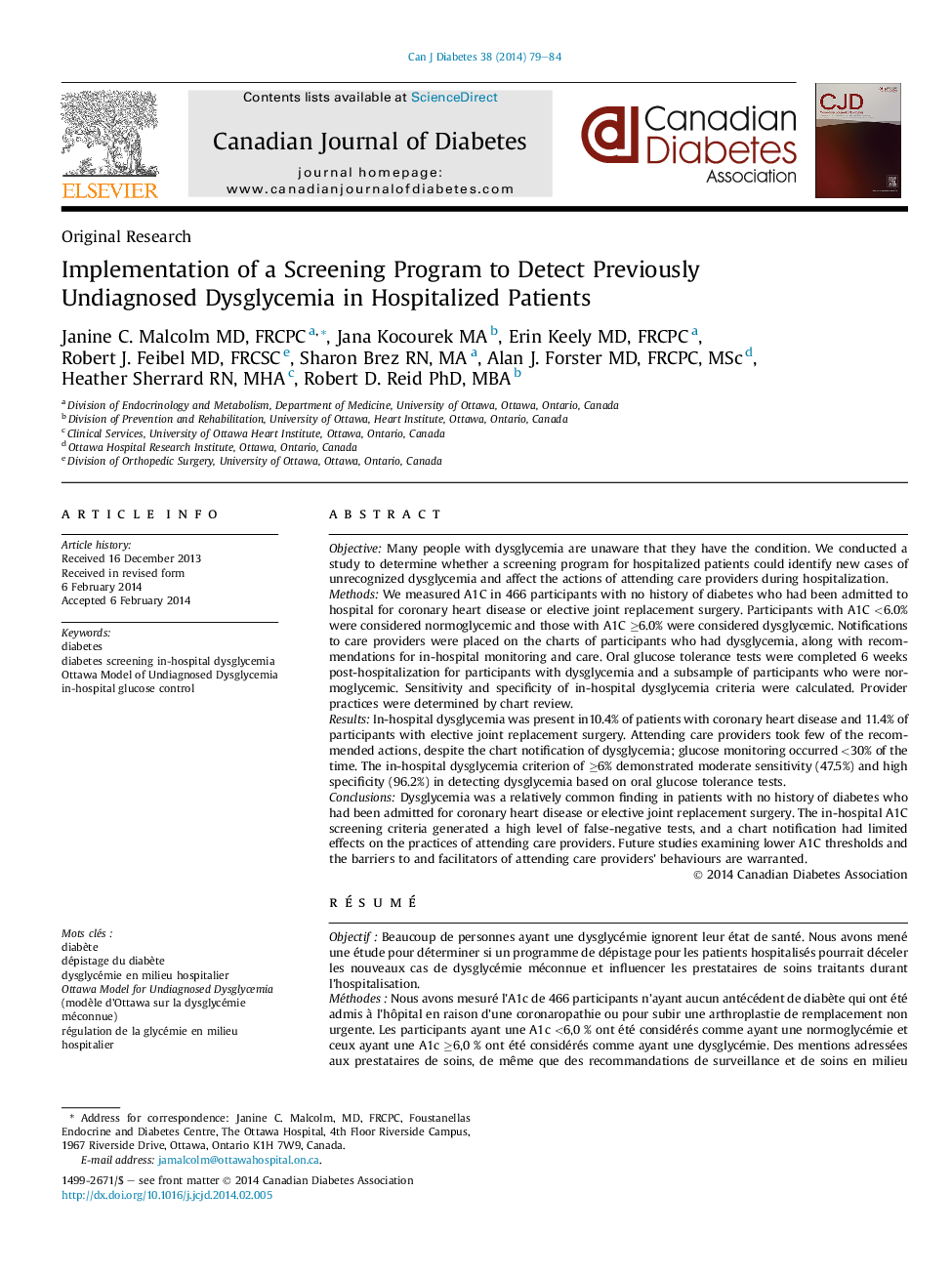| Article ID | Journal | Published Year | Pages | File Type |
|---|---|---|---|---|
| 3255188 | Canadian Journal of Diabetes | 2014 | 6 Pages |
ObjectiveMany people with dysglycemia are unaware that they have the condition. We conducted a study to determine whether a screening program for hospitalized patients could identify new cases of unrecognized dysglycemia and affect the actions of attending care providers during hospitalization.MethodsWe measured A1C in 466 participants with no history of diabetes who had been admitted to hospital for coronary heart disease or elective joint replacement surgery. Participants with A1C <6.0% were considered normoglycemic and those with A1C ≥6.0% were considered dysglycemic. Notifications to care providers were placed on the charts of participants who had dysglycemia, along with recommendations for in-hospital monitoring and care. Oral glucose tolerance tests were completed 6 weeks post-hospitalization for participants with dysglycemia and a subsample of participants who were normoglycemic. Sensitivity and specificity of in-hospital dysglycemia criteria were calculated. Provider practices were determined by chart review.ResultsIn-hospital dysglycemia was present in10.4% of patients with coronary heart disease and 11.4% of participants with elective joint replacement surgery. Attending care providers took few of the recommended actions, despite the chart notification of dysglycemia; glucose monitoring occurred <30% of the time. The in-hospital dysglycemia criterion of ≥6% demonstrated moderate sensitivity (47.5%) and high specificity (96.2%) in detecting dysglycemia based on oral glucose tolerance tests.ConclusionsDysglycemia was a relatively common finding in patients with no history of diabetes who had been admitted for coronary heart disease or elective joint replacement surgery. The in-hospital A1C screening criteria generated a high level of false-negative tests, and a chart notification had limited effects on the practices of attending care providers. Future studies examining lower A1C thresholds and the barriers to and facilitators of attending care providers’ behaviours are warranted.
RésuméObjectifBeaucoup de personnes ayant une dysglycémie ignorent leur état de santé. Nous avons mené une étude pour déterminer si un programme de dépistage pour les patients hospitalisés pourrait déceler les nouveaux cas de dysglycémie méconnue et influencer les prestataires de soins traitants durant l’hospitalisation.MéthodesNous avons mesuré l’A1c de 466 participants n’ayant aucun antécédent de diabète qui ont été admis à l’hôpital en raison d’une coronaropathie ou pour subir une arthroplastie de remplacement non urgente. Les participants ayant une A1c <6,0 % ont été considérés comme ayant une normoglycémie et ceux ayant une A1c ≥6,0 % ont été considérés comme ayant une dysglycémie. Des mentions adressées aux prestataires de soins, de même que des recommandations de surveillance et de soins en milieu hospitalier ont été placées aux dossiers des participants qui avaient une dysglycémie. Les épreuves d’hyperglycémie provoquée par voie orale ont été réalisées 6 semaines après l’hospitalisation des participants qui avaient une dysglycémie et d’un sous-échantillon de participants qui avaient une normoglycémie. La sensibilité et la spécificité des critères de dysglycémie en milieu hospitalier ont été calculées. Les pratiques des prestataires ont été déterminées par l’étude du dossier.RésultatsLa dysglycémie en milieu hospitalier était présente chez 10,4 % des patients atteints d’une coronaropathie et chez 11,4 % des participants admis pour une arthroplastie de remplacement non urgente. Les prestataires de soins traitants ont mis peu des mesures recommandées en pratique, en dépit de l’avis de dysglycémie au dossier; la surveillance glycémique a été effectuée <30 % du temps. Le critère de dysglycémie en milieu hospitalier de ≥6 % a démontré une sensibilité modérée (47,5 %) et une spécificité élevée (96,2 %) dans la détection de la dysglycémie selon les épreuves d’hyperglycémie provoquée par voie orale.ConclusionsLa dysglycémie a été assez fréquemment observée chez les patients n’ayant aucun antécédent de diabète qui avaient été admis en raison d’une coronaropathie ou d’une arthroplastie de remplacement non urgente. Les critères de dépistage de l’A1c en milieu hospitalier ont généré un nombre élevé d’épreuves faussement négatives, et un avis au dossier avait limité les effets sur les pratiques des prestataires de soins traitants. D’autres études examinant des seuils plus faibles d’A1c, et les obstacles aux comportements des prestataires de soins traitants et les facilitateurs de ceux-ci sont justifiées.
